- Francesco Pennisi
- Johann Krebs
- contemporary music
- Muti
- Alice Goodman
- Shell Canada
- Worcester UK
- Vato Klemera
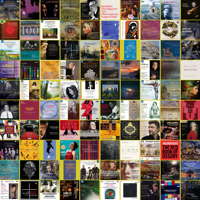 UPDATES: There's a new feature every day at Classical Music Daily. Read about the various ways we can keep in touch with you about what's happening here.
UPDATES: There's a new feature every day at Classical Music Daily. Read about the various ways we can keep in touch with you about what's happening here.
 DISCUSSION: What is a work? John Dante Prevedini leads a discussion about The performing artist as co-creator, including contributions from Halida Dinova, Yekaterina Lebedeva, Béla Hartmann, David Arditti and Stephen Francis Vasta.
DISCUSSION: What is a work? John Dante Prevedini leads a discussion about The performing artist as co-creator, including contributions from Halida Dinova, Yekaterina Lebedeva, Béla Hartmann, David Arditti and Stephen Francis Vasta.

A Clear Success
GIUSEPPE PENNISI listens to
contemporary music in a baroque setting
contemporary music in a baroque setting
The international music press seldom deals with contemporary music in Italy, even though (on a yearly basis) as many hours of contemporary music are performed in Rome as in Berlin. Since 1930, Venice has featured a festival of contemporary music; historians say that the then head of government, Benito Mussolini, was a fan of contemporary music and intended to challenge Salzburg with the Venice festival where all the composers disliked by Hitler and Goebbels were routinely invited.
I have occasionally reported here on contemporary music in Italy, for instance in my feature Youthful Composers on 22 October 2013. A major contribution is offered by Rome-based Academies and Cultural Institutes of foreign countries. Most of them were established to provide training and exposure to archeology and Latin literature. Gradually their scope has been expanded to encompass all the visual arts and music. Since their 'fellows' are young, they are a laboratory of both contemporary visual arts and music.
A very active Academy is that of the Federal Republic of Germany, headquartered in Villa Massimo in Rome and with a facility also in the countryside, in Oliveto Romano. Villa Massimo was acquired in 1910 by a Prussian entrepreneur and benefactor of the arts, Eduard Arnhold, and became the home of the Academy. A distinct feature is that the 'fellows' are chosen through a major and very keen competition; they do not need to be German - many other academies accept only their nationals - but they have to have had a residence in Germany for no less than five years. This accounts for the Academy's cultural vivacity.
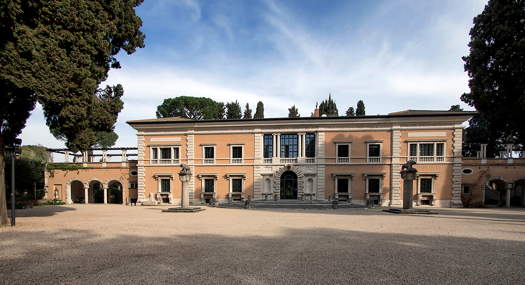
Villa Massimo
Among the groups of fellows, the musicians have several venues where they can perform and present their new works. A very special concert of contemporary music was held on 10 March 2019 to celebrate the retirement, after seventeen years in Rome, of the Academy director, Joachim Blüher. A new director, Julia Draganović, will take over next June.
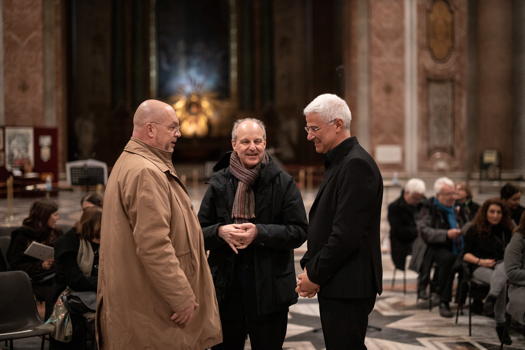
From left to right: Joachim Blüher, Nicola Sani and Tonino Battista in the Basilica di Santa Maria degli Angeli e dei Santi. Photo © 2019 Alberto Novelli
At the composers' request, the concert was held not in a regular auditorium but in the huge Basilica di Santa Maria degli Angeli e dei Santi, which has perfect acoustics. I remember that in 1983, several performances of Wagner's Parsifal were offered there in concert form because, due to a fire, the Teatro dell'Opera stage was not operative. The Basilica was built, in baroque times, within Emperor Diocletian's enormous Thermal Baths.
For the purposes of the concert, in the center of the transept, the audience was sitting in five rows of a circle or a ring; the conductor was in the center of the circle; the instrumentalists and the chorus were around the circle, thus providing excellent stereophonic effects.
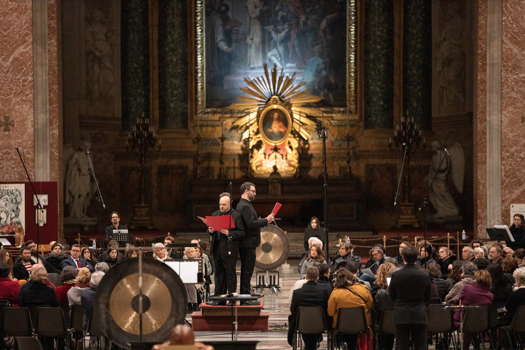
From left to right: Oliviero Giorgiutti and Victor Andrini. Photo © 2019 Alberto Novelli
The concert included three short and very seldom played pieces by Giacinto Scelsi: the Three Latin Prayers composed in 1972. They last three minutes each and are quite peculiar in Scelsi's work: they are an Ave Maria, Paternoster and Alleluja, sung here by a small male chorus, and recall Gregorian music as re-discovered in the second part of the nineteenth century. For these pieces - two in between the two central compositions of the evening and the third at the end of the concert - four members of the Evo choral ensemble sang in the center of the ring on the stand where, for the rest of the concert, the conductor stood.
I have written several features on Scelsi here. The Three Latin Prayers are unique and reflect the composer's deep religious feelings, which are closer to Asian faiths than to those of Western Europe.
The main fare was by two fellows of the Academy: the Ukrainian Anna Korsun and the Canadian Samy Moussa.
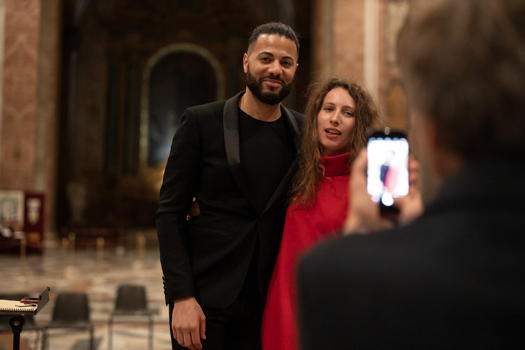
Samy Moussa and Anna Korsun in Rome. Photo © 2019 Alberto Novelli
Ulenflucht (The Flight of the Owls) by Anna Korsun is a charming seventeen-minute choral work for twenty performers who sing and play an onomatopoeic composition describing the flight of owls. The Evo ensemble was supplemented by the vocal ensemble Voxnova Italia. Tonino Battista, a contemporary music specialist, was on the podium. The audience liked it and applauded warmly.
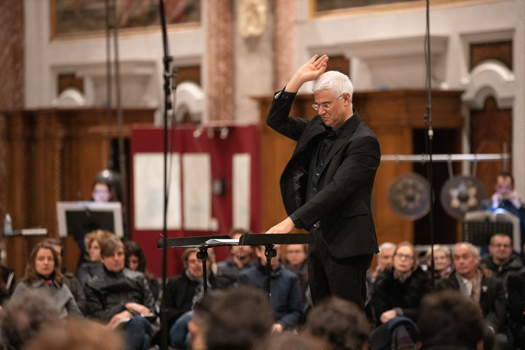
Tonino Batista conducting at Santa Maria degli Angeli in Rome. Photo © 2019 Alberto Novelli
However, the listeners were also enthusiastic about Sami Moussa's Stasis, a fifteen minute piece in four movements. The composition is a commission by the Bayerische Staatsoper with the support of Munich's Archdiocese and of the Association of the Friends of the Staatsoper. It requires eight French horns, seventeen gongs and two tam-tams - an impressive ensemble.
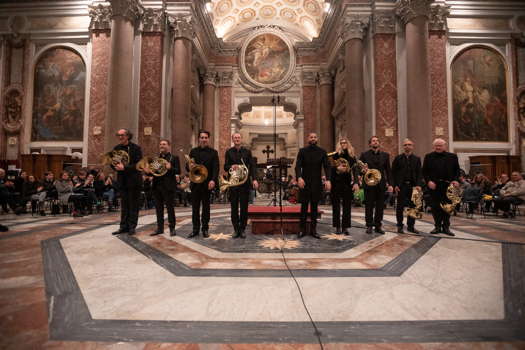
Samy Moussa (centre right) with Munich Opera Horns. Photo © 2019 Alberto Novelli
Stasis describes an atemporal and limitless acoustic space where the listener can contemplate and concentrate. Moussa merges elements from various faiths: a Jewish shofar, and Tibetan religious songs. The sound of the horns is skillfully mixed with that of the gongs. A clear success.
Rome, Italy


